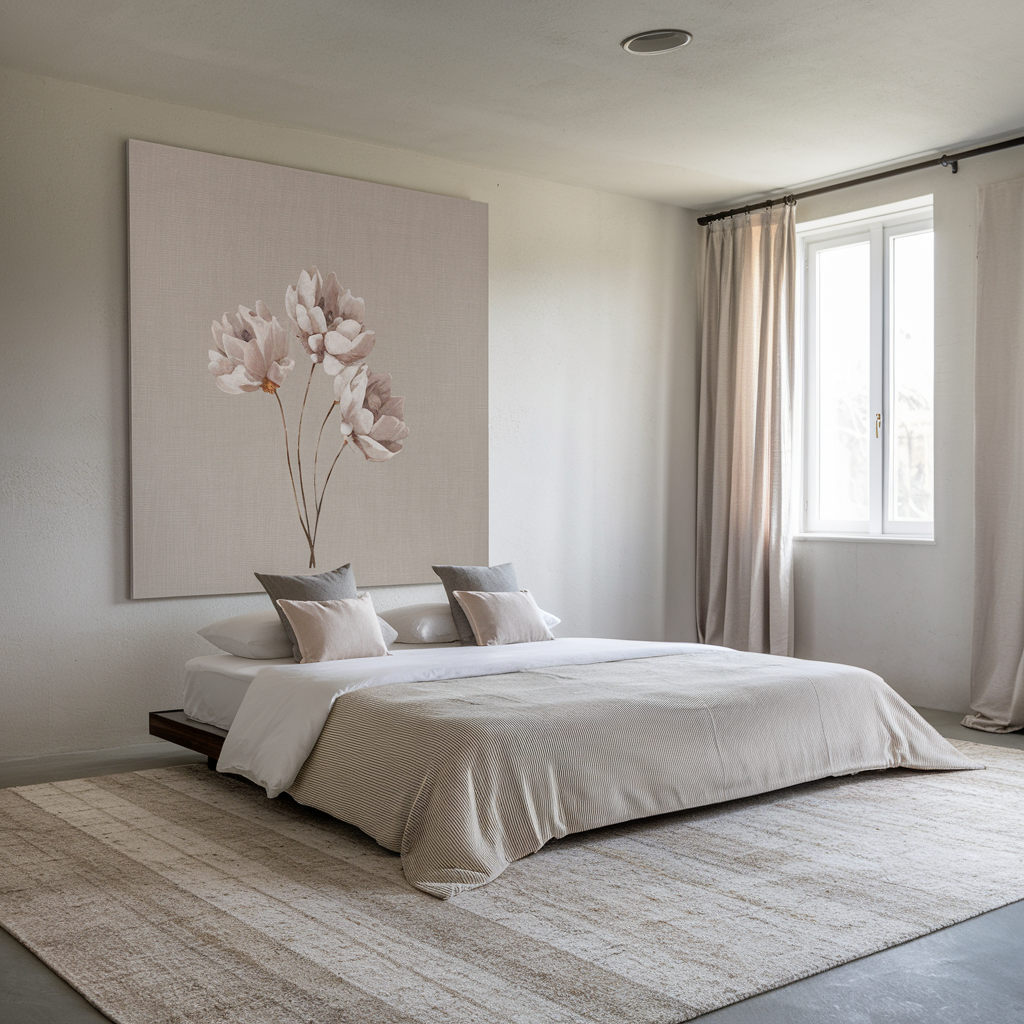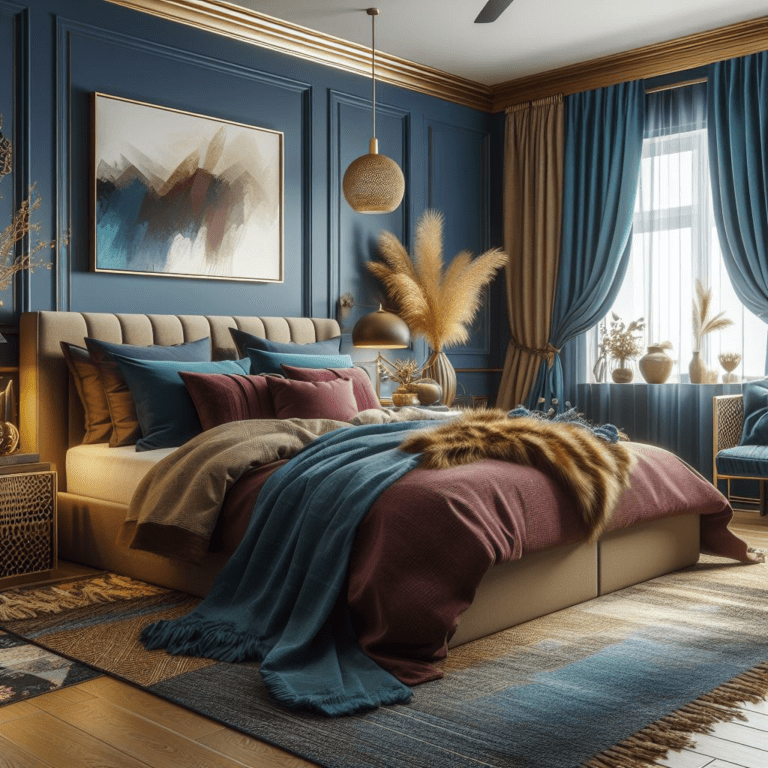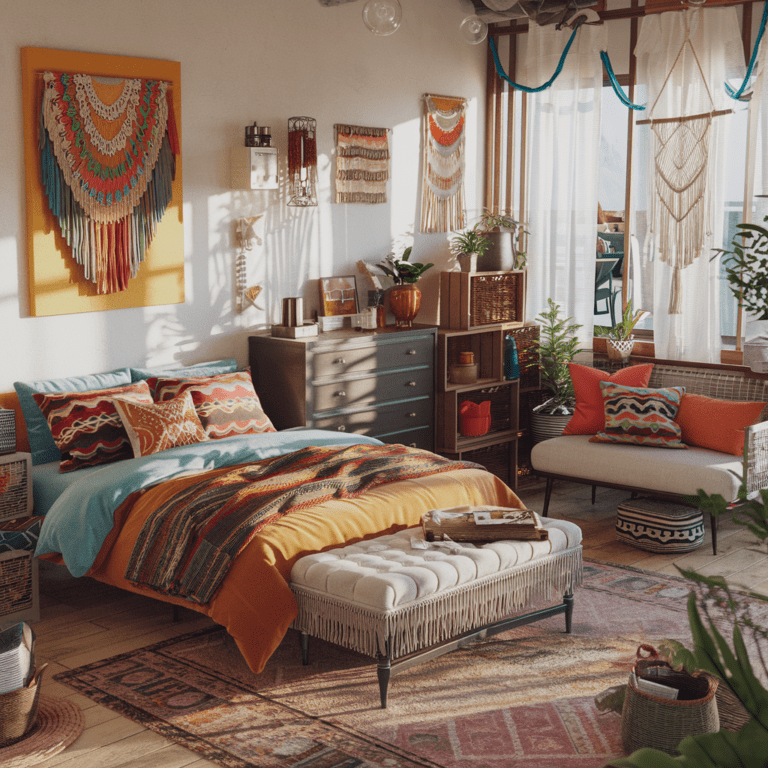19 Minimalistic Bedroom Ideas For A Clutter-Free, Peaceful Home
This post may contain affiliate links. As an Amazon Associate, I earn from qualifying purchases at no extra cost to you. Read my full disclosure.
A minimalist bedroom is more than just a design choice; it’s a commitment to creating a serene, clutter-free space that promotes peace of mind and better living.
With thoughtful decor, furniture, and layout choices, a minimalist bedroom can be transformed into a calming sanctuary that combines style and functionality.
In this article, we’ll explore 19 inspiring ideas to help you achieve a clean, harmonious, and beautifully simple bedroom environment that feels like a true retreat from the outside world.
1. Choosing a Neutral Color Palette
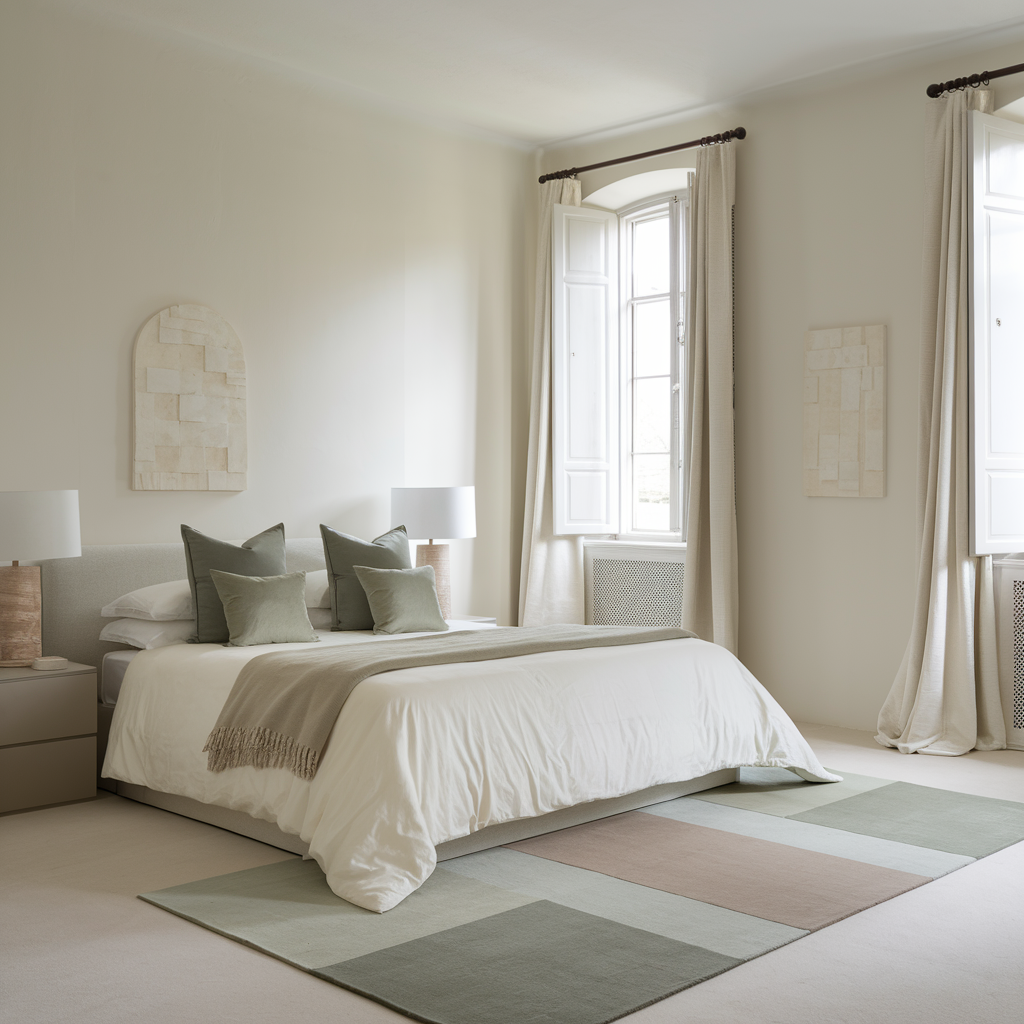
Choosing a neutral color palette creates a calming and timeless foundation for a minimalist bedroom. Soft whites and creams on the walls and bedding establish a bright, airy atmosphere that promotes relaxation.
Light gray furniture, such as a dresser or nightstand, adds subtle contrast while maintaining the room’s cohesive simplicity. Muted accent colors like sage green or taupe can be introduced through throw pillows or an area rug to provide depth without overwhelming the space.
Using natural wood tones for furniture or decor complements the neutral palette and brings warmth, ensuring the room feels inviting yet uncluttered.
2. Investing in Functional Furniture
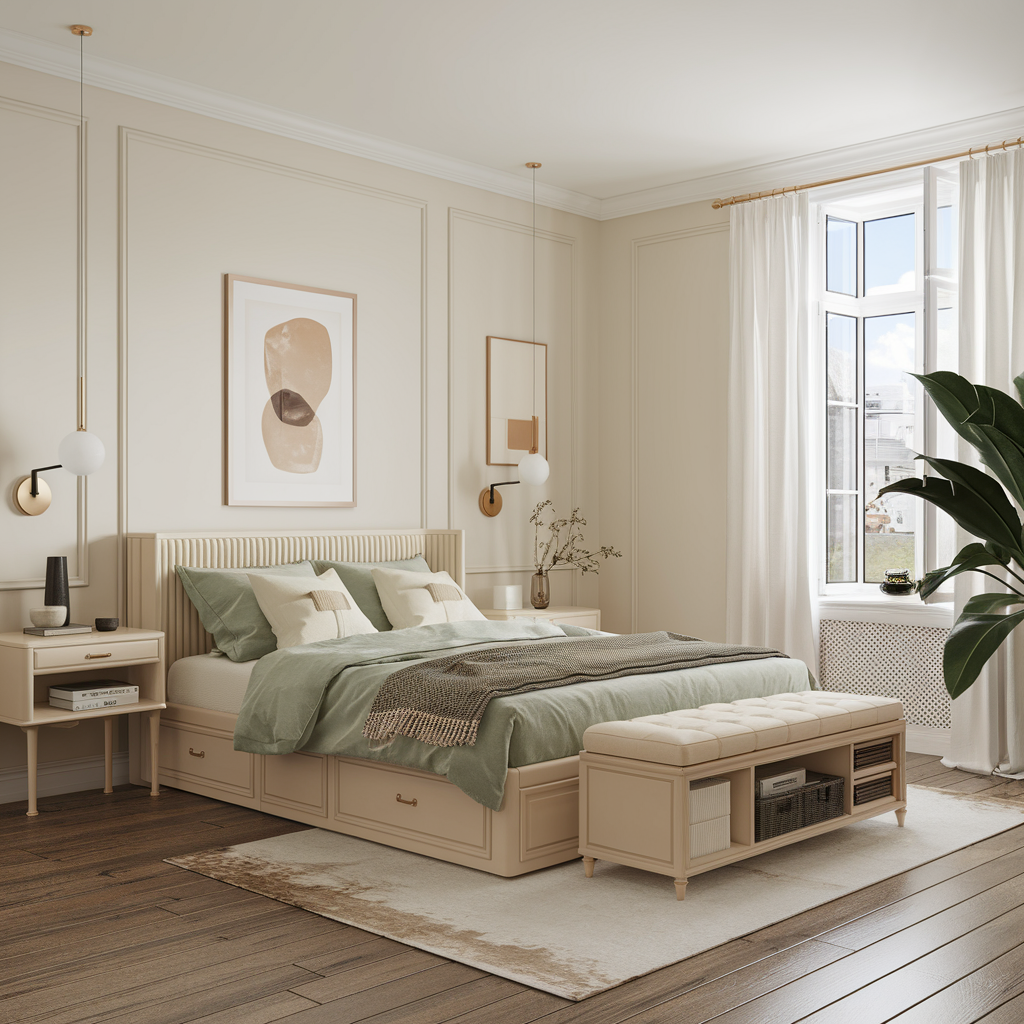
Functional furniture is essential for maintaining a minimalist bedroom that balances style and practicality. A storage bed with built-in drawers provides ample space to store bedding, clothing, or seasonal items, reducing the need for bulky dressers.
Nightstands with a clean, simple design and built-in shelves or drawers offer a discreet place to keep books, chargers, and personal items organized. A wardrobe with built-in compartments or adjustable shelves can maximize storage while keeping your space visually streamlined.
Multi-purpose pieces like a bench with hidden storage or a wall-mounted desk can enhance functionality without adding clutter, making them ideal for smaller bedrooms or a sleek, minimalist look.
3. Decluttering and Storage Solutions
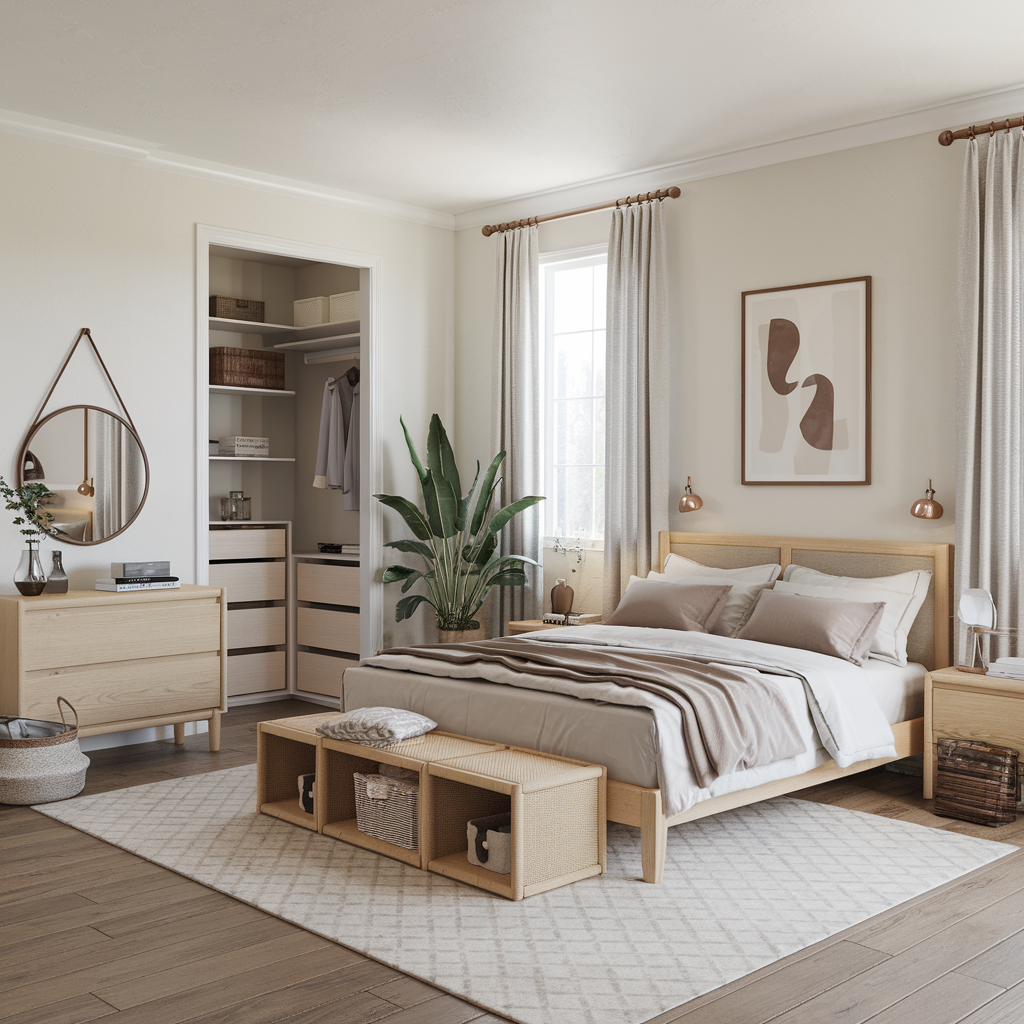
Decluttering and storage solutions are vital for maintaining the simplicity of a minimalist bedroom. Start by removing items that no longer serve a purpose, prioritizing only what adds value or functionality to the space.
Under-bed storage boxes or bins with lids provide an effective way to store seasonal clothing or extra bedding out of sight. Woven baskets or fabric storage cubes are excellent for organizing small items like accessories, books, or electronics, and keeping surfaces clear.
Drawer organizers and closet dividers maximize available space, ensuring each item has a designated place, which makes the room easier to keep tidy and clutter-free.
4. Simplified Bedding Choices
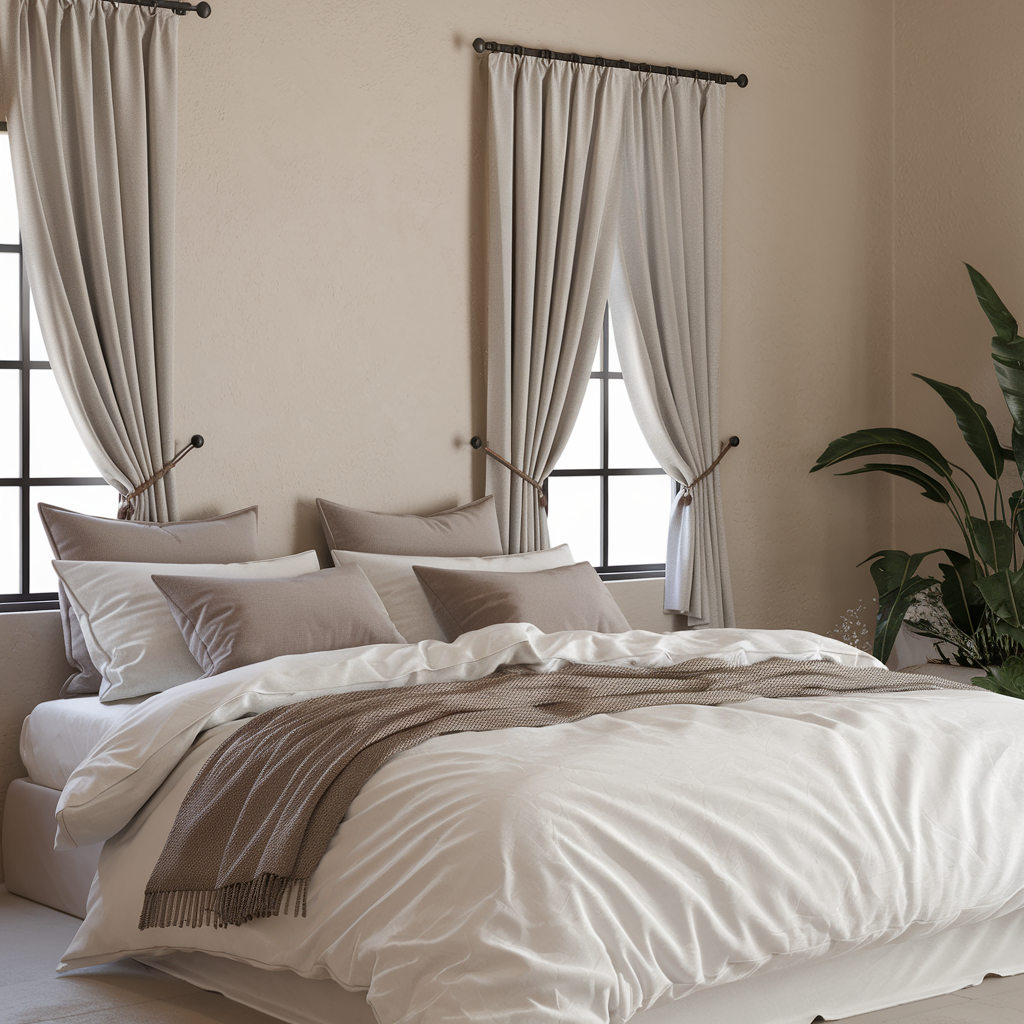
Simplified bedding choices contribute to the clean and serene aesthetic of a minimalist bedroom. Opt for high-quality, solid-colored sheets in materials like cotton or linen that feel comfortable and look effortlessly elegant.
A crisp white duvet cover creates a timeless and airy look, while light gray or beige alternatives can add a hint of warmth. Layering with a single textured throw blanket or a minimal number of accent pillows in muted tones maintains visual balance without overcrowding the bed.
Prioritizing breathable and easy-to-care-for fabrics ensures the bedding remains both practical and inviting.
5. Incorporating Natural Elements
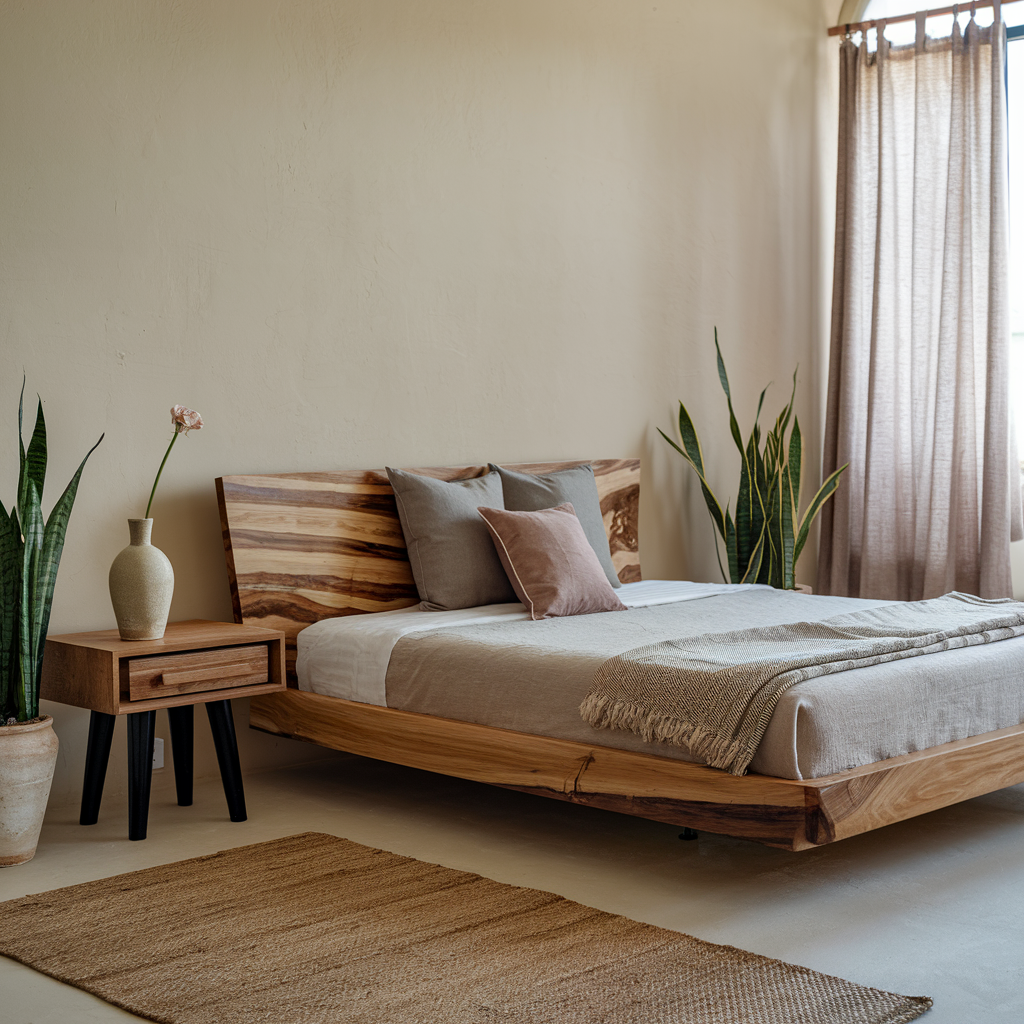
Incorporating natural elements brings warmth and tranquility to a minimalist bedroom. Wooden furniture, such as a bed frame or nightstand with visible grain, adds organic texture and complements a neutral color palette.
Potted plants, like a snake plant or peace lily, introduce greenery and purify the air, enhancing the room’s calming atmosphere. Decor pieces made of natural materials, such as woven baskets, ceramic vases, or stone accents, provide subtle variation while maintaining simplicity.
Linen curtains or a jute area rug further connect the space to nature, creating a serene and grounded environment.
6. Strategic Lighting Options
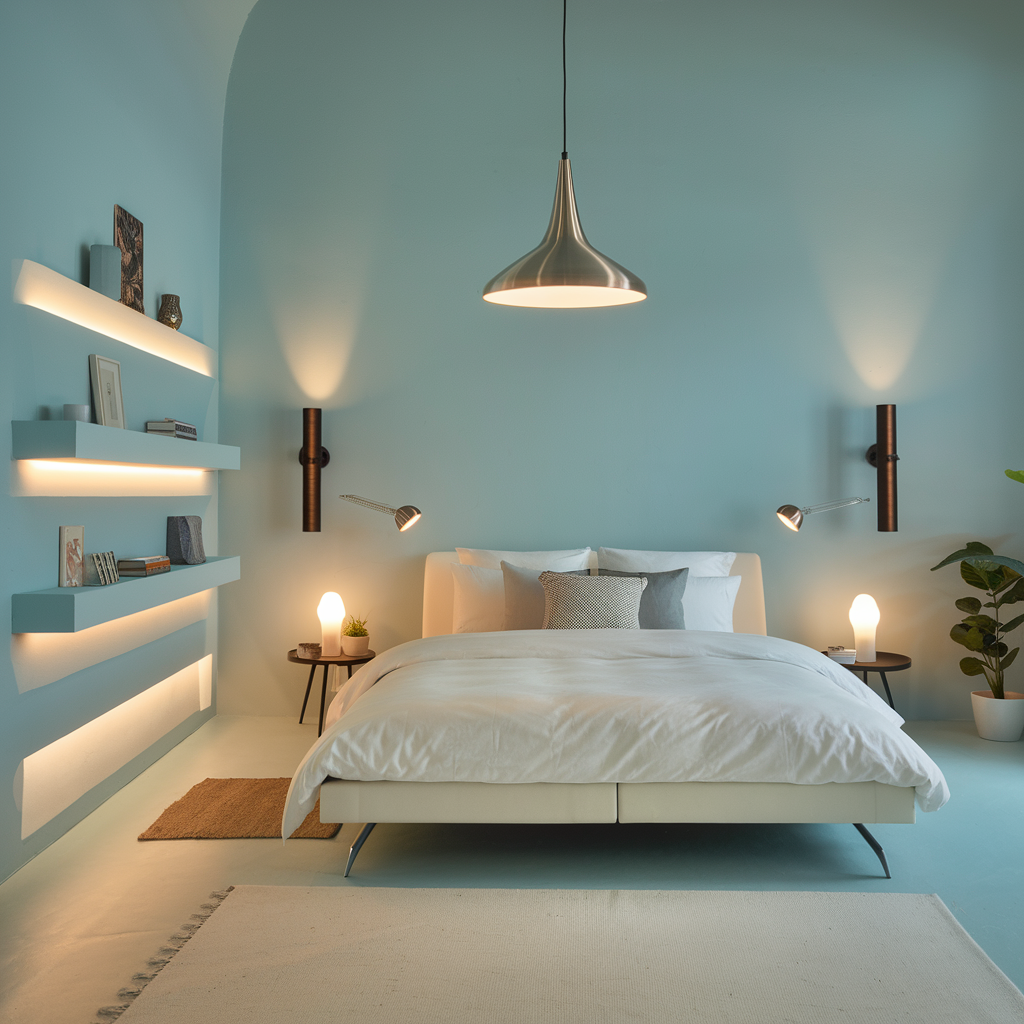
Strategic lighting options are essential for creating a cozy and functional minimalist bedroom. A pendant light with a sleek design can provide soft ambient illumination, establishing a warm and inviting atmosphere.
Bedside table lamps with adjustable brightness offer focused task lighting, ideal for reading or winding down in the evening. Wall-mounted sconces save space while adding a modern touch and ensuring balanced lighting throughout the room.
LED strip lights under shelves or behind a headboard create a soft, indirect glow that enhances the minimalist aesthetic without being overpowering. Using sheer curtains allows natural light to filter in during the day, maintaining the room’s open and serene vibe.
7. Minimal Wall Decor
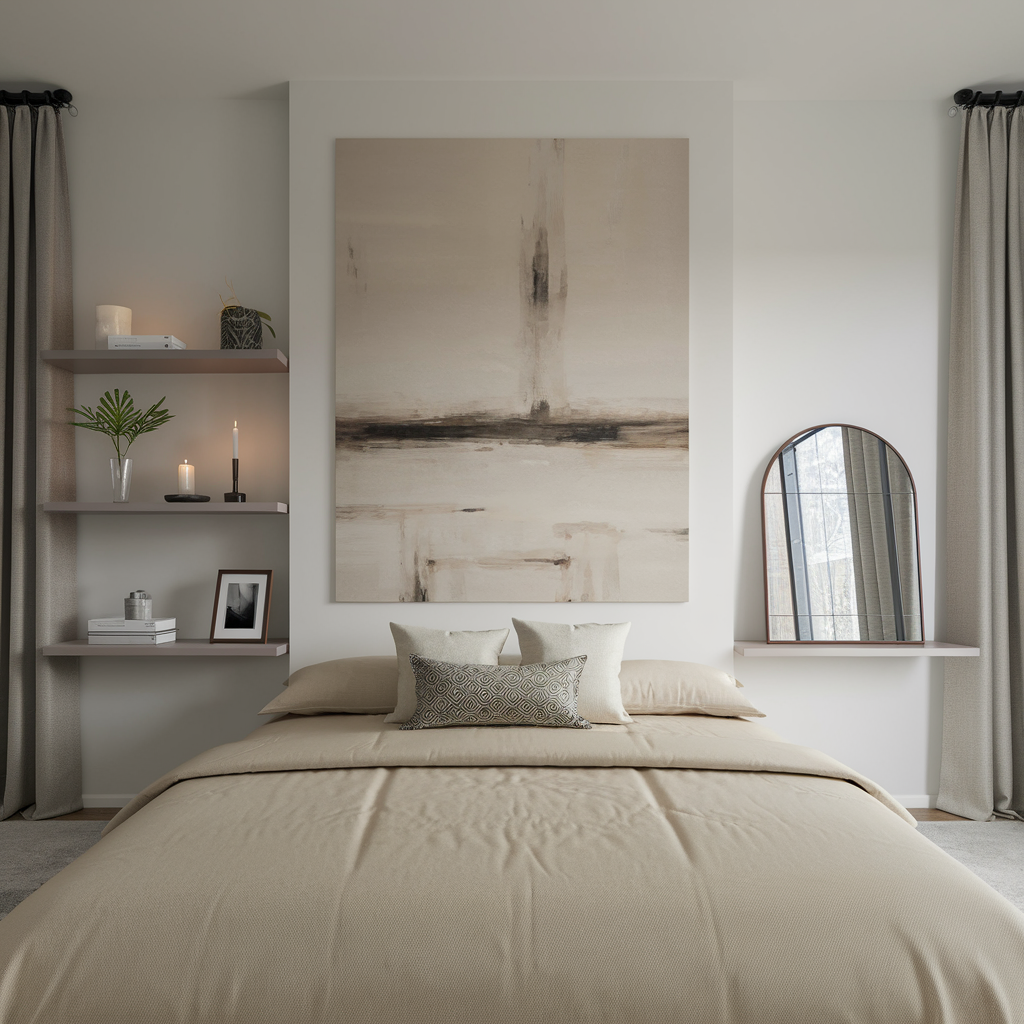
Minimal wall decor enhances the clean and uncluttered look of a minimalist bedroom while adding subtle personality. A single large piece of artwork, such as a monochromatic abstract painting or a serene nature photograph, creates a focal point without overcrowding the space.
Floating shelves with a few carefully curated items, like a small plant, a candle, or a framed photo, provide visual interest while keeping the walls uncluttered. Neutral or natural-finished frames for any wall art blend seamlessly with the overall aesthetic, ensuring cohesion.
Mirrors with simple or frameless designs can reflect light and make the room feel larger, doubling as decor while serving a practical purpose. Keeping the number of pieces limited allows the walls to maintain a sense of openness and calm.
8. Maximizing Natural Light
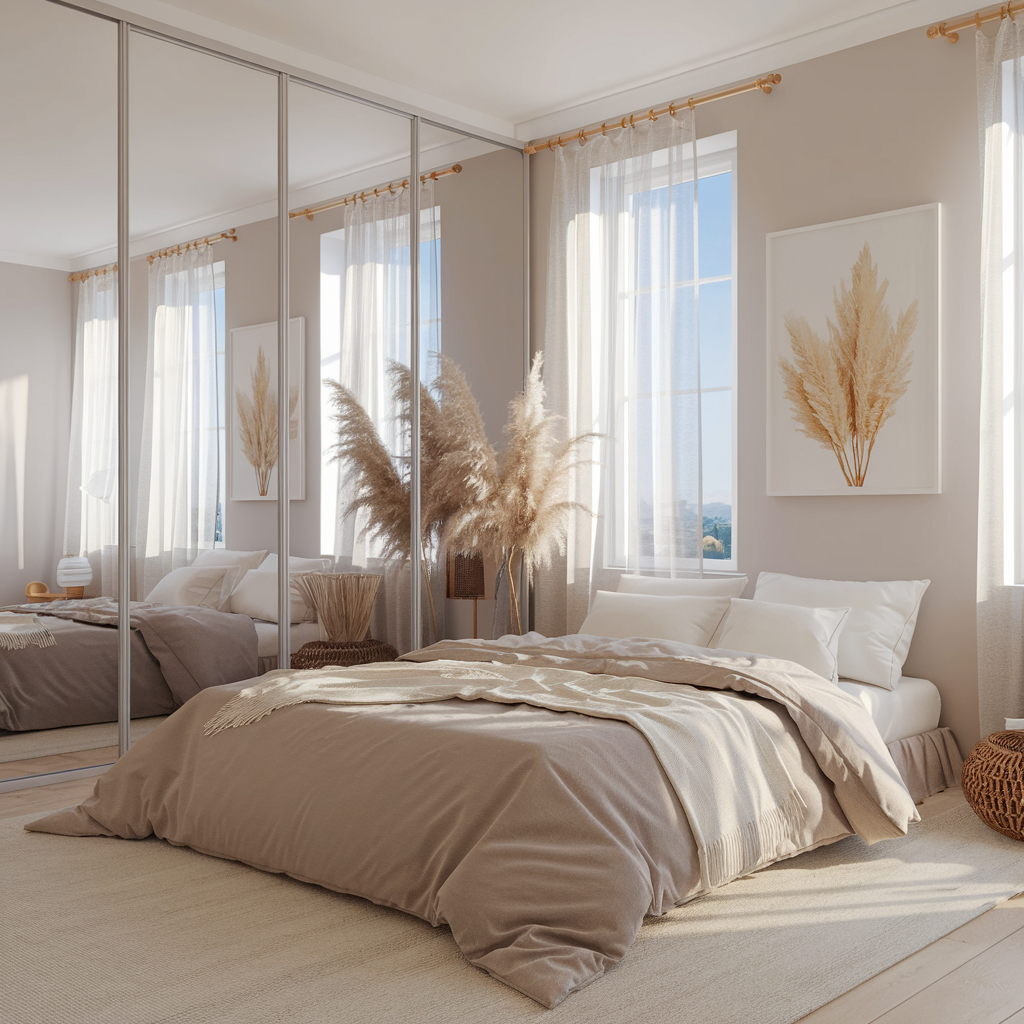
Maximizing natural light creates a bright and tranquil ambiance in a minimalist bedroom. Light-colored curtains or sheer drapes allow sunlight to filter in while maintaining privacy and softness.
Using light-reflective paint finishes, such as satin or eggshell, on the walls helps enhance the natural illumination in the space. Strategically placing mirrors across from windows increases the distribution of light, making the room feel more spacious.
Minimal window treatments, like roller blinds or lightweight shades, keep the design clean while ensuring sunlight isn’t obstructed. Keeping furniture away from windows ensures that natural light flows through the space without interruption.
9. Maintaining Clean Lines in Design
Maintaining clean lines in design is key to achieving a polished and minimalist bedroom aesthetic. Furniture with simple, straight edges, such as a platform bed or a streamlined dresser, creates a sense of order and balance.
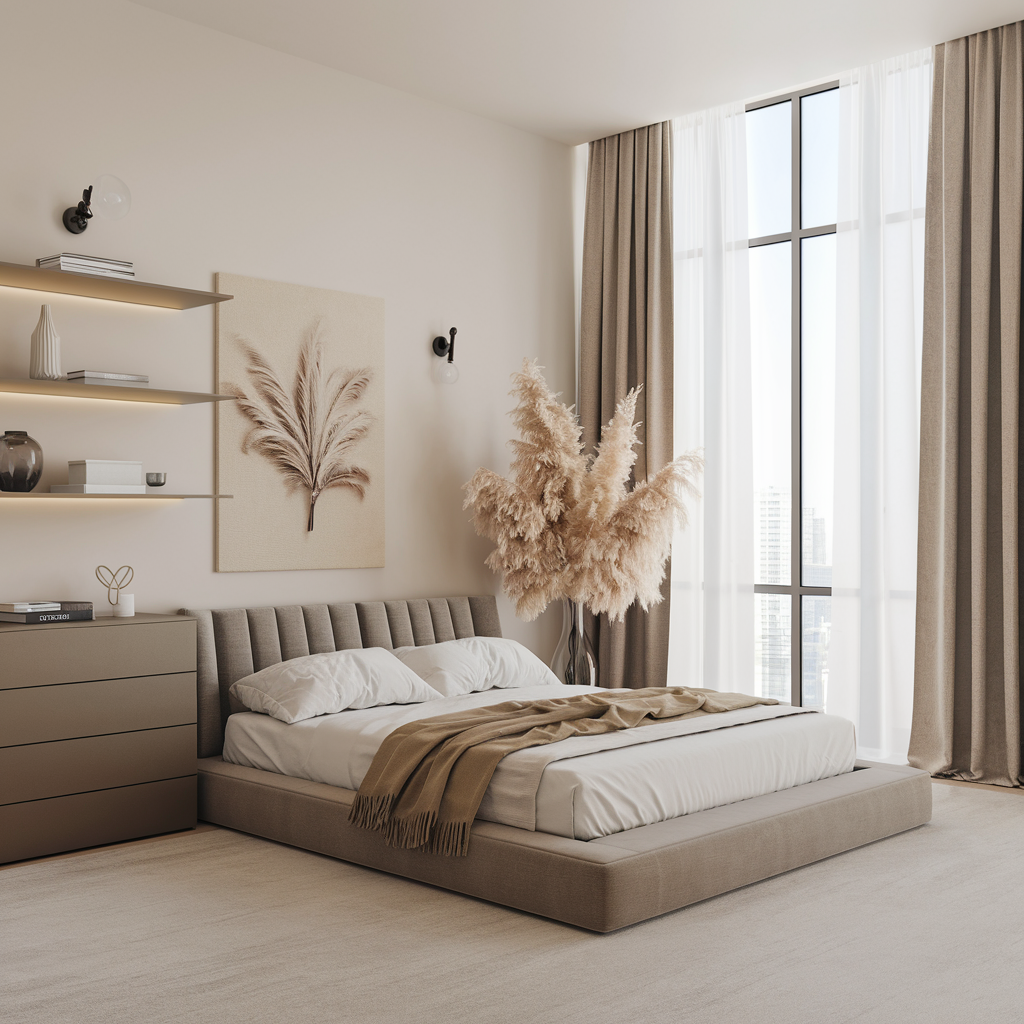
Avoiding ornate details or heavy carvings ensures the focus remains on the room’s functionality and flow. Floating shelves or wall-mounted lighting enhances visual simplicity by reducing the need for bulky pieces.
Aligning furniture parallel to walls and maintaining symmetry in layouts further emphasizes the sleek, uncluttered design. Incorporating built-in storage solutions also preserves clean lines by keeping items out of sight, contributing to a tidy and harmonious space.
10. Adding Subtle Textures
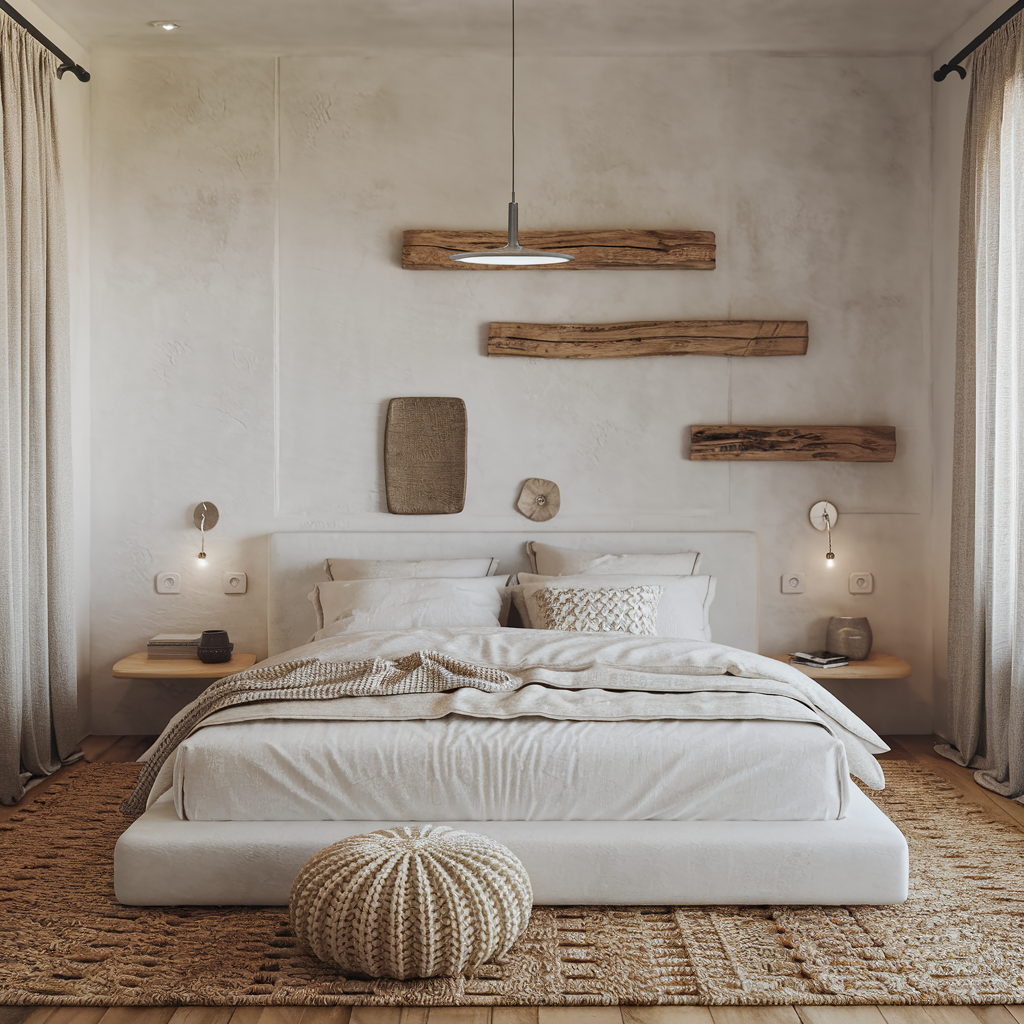
Adding subtle textures brings depth and warmth to a minimalist bedroom without compromising its simplicity. A woven jute or sisal rug under the bed introduces an organic, tactile element to the space.
Linen bedding with its natural crinkles offers a relaxed yet refined feel, complementing the room’s understated design. Throw pillows or blankets in soft, knitted fabrics can enhance the coziness while adhering to the minimalist aesthetic.
Curtains made of lightweight cotton or sheer materials add an airy texture that softens the overall look. Incorporating matte ceramics or unfinished wood in decor pieces maintains the room’s serene atmosphere while adding visual interest through subtle variation.
11. Creating a Focal Point
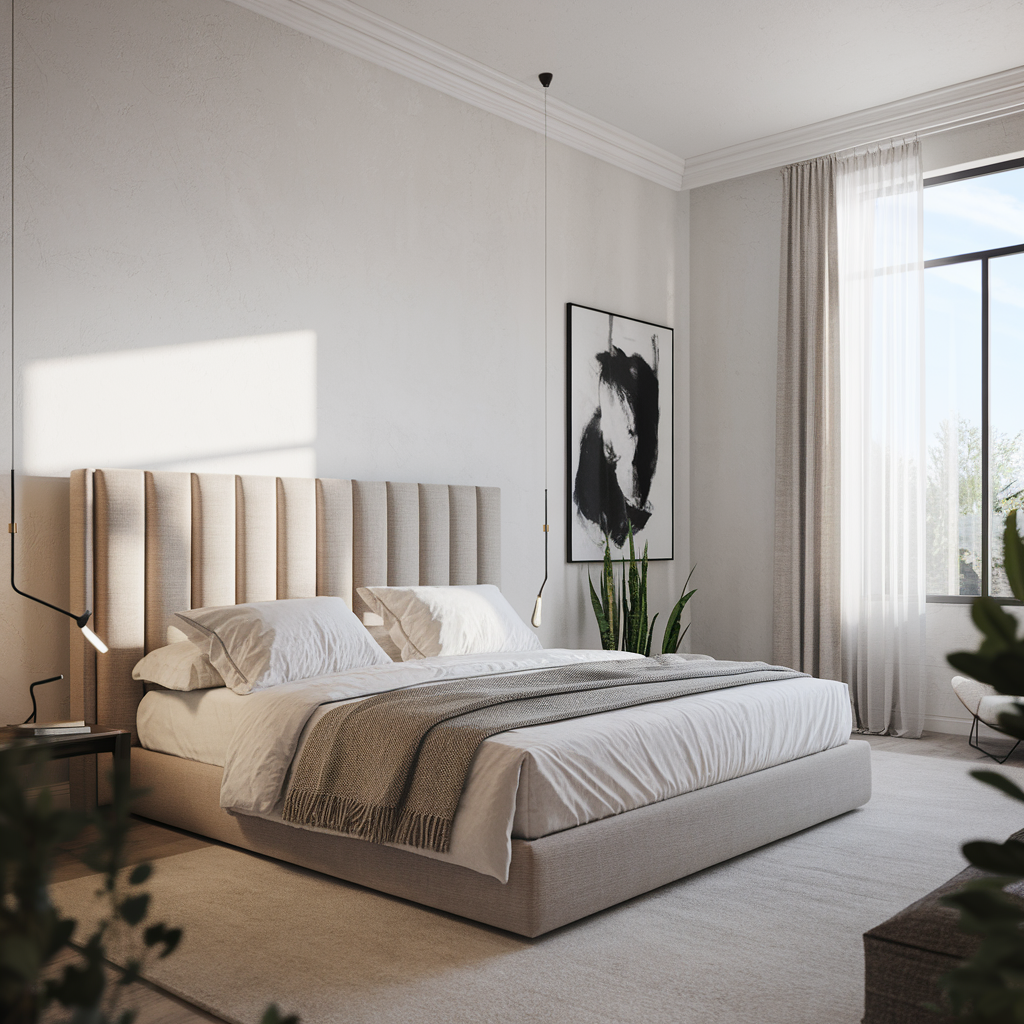
Creating a focal point in a minimalist bedroom draws the eye and adds a sense of purpose to the design. A statement headboard in a neutral tone, such as upholstered fabric or natural wood, can become the centerpiece of the room.
A large piece of wall art, like an abstract painting or a black-and-white photograph, provides visual interest without overwhelming the space. A neatly styled bed with crisp bedding and a textured throw can also serve as the room’s anchor, highlighting its simplicity and elegance.
Adding a unique light fixture, such as a sleek pendant or sculptural bedside lamp, directs attention while maintaining the clean, minimalist vibe. The focal point should remain cohesive with the overall design, ensuring it enhances the room’s serene and balanced feel.
12. Technology-Free Zones
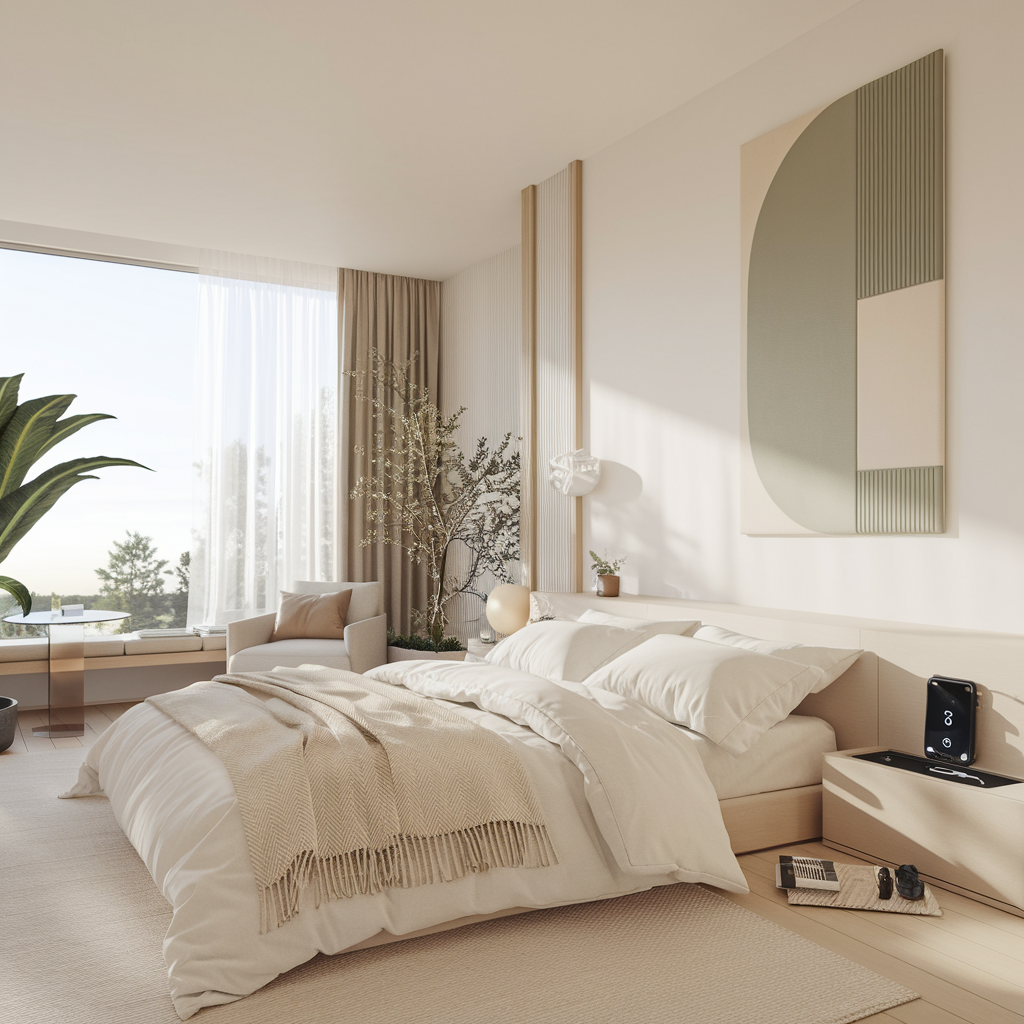
Designating technology-free zones in a minimalist bedroom helps maintain its calming and restful atmosphere. Keeping devices like televisions, laptops, and phones out of the bedroom encourages better sleep and fosters relaxation.
A small tray or drawer on a nightstand can serve as a designated spot to store devices, keeping them out of sight and reducing visual clutter. Incorporating analog alternatives, such as an alarm clock instead of a smartphone, supports the technology-free approach while complementing the minimalist design.
Setting up a cozy reading nook with a comfortable chair and a soft light provides a distraction-free space for unwinding without digital interruptions. This intentional separation of technology promotes mindfulness and reinforces the room’s tranquil purpose.
13. Using Mirrors to Enhance Space

Using mirrors effectively can make a minimalist bedroom feel larger and more open while adding a touch of elegance. Placing a large, frameless mirror against a wall helps reflect natural light throughout the space, creating a brighter and more expansive atmosphere.
A round mirror with a simple frame above a dresser or console provides both function and style, serving as a sleek design element. Full-length mirrors positioned near windows amplify the room’s sense of depth by capturing outdoor views and extending them visually.
Clustered smaller mirrors with clean, geometric designs can add subtle interest to a wall while maintaining the minimalist aesthetic. Mirrors not only enhance the perception of space but also contribute to the overall harmony of the room.
14. Avoiding Overly Trendy Pieces
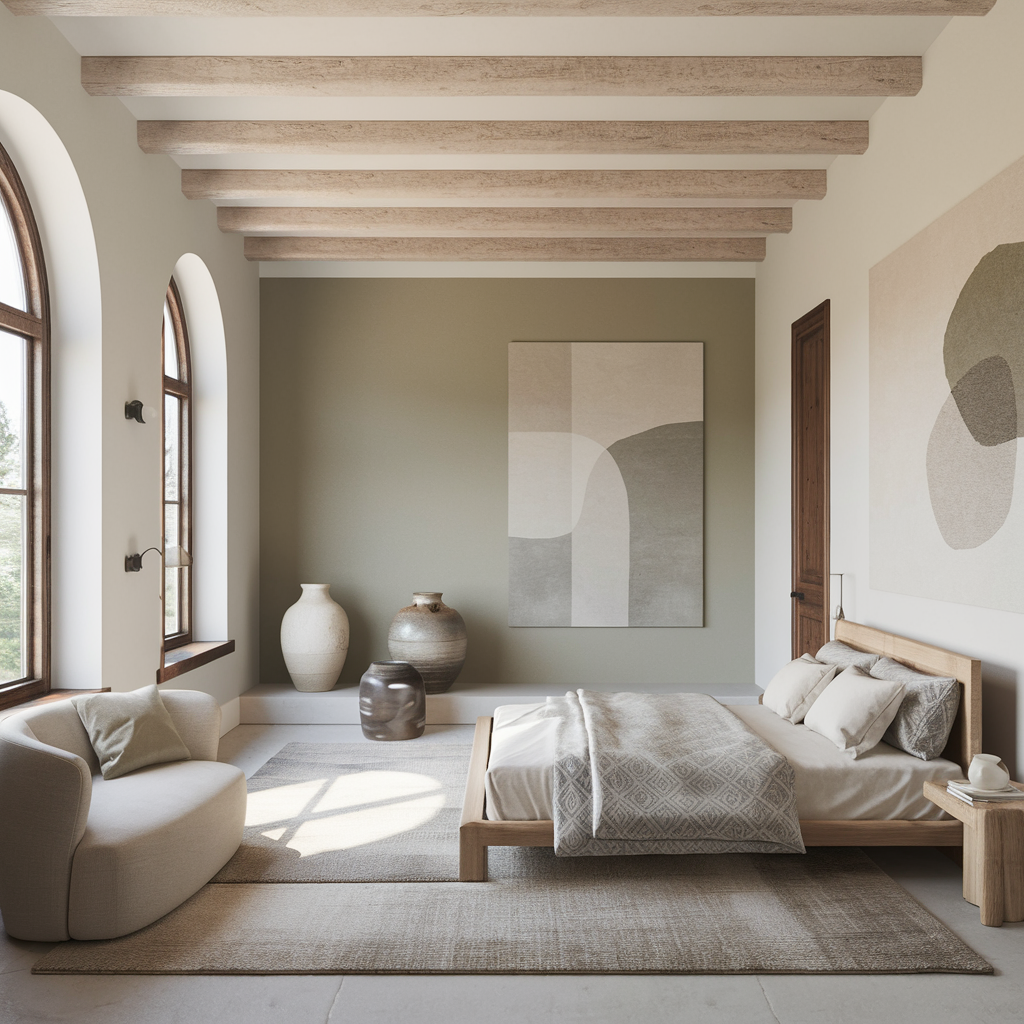
Avoiding overly trendy pieces ensures a minimalist bedroom remains timeless and cohesive. Opting for classic, well-crafted furniture, like a simple wooden bed frame or a neutral-toned sofa chair, prevents the space from feeling dated as trends shift.
Decor items in natural materials, such as ceramic vases or linen throws, offer enduring appeal without the risk of looking out of place over time. Choosing subtle patterns or solid colors for bedding and rugs creates a versatile foundation that can adapt to future updates.
Investing in durable, high-quality pieces ensures longevity and aligns with the minimalist philosophy of valuing functionality over fleeting fashion. This approach maintains the room’s calm and understated aesthetic, free from the clutter of passing trends.
15. Maintaining Open Floor Space
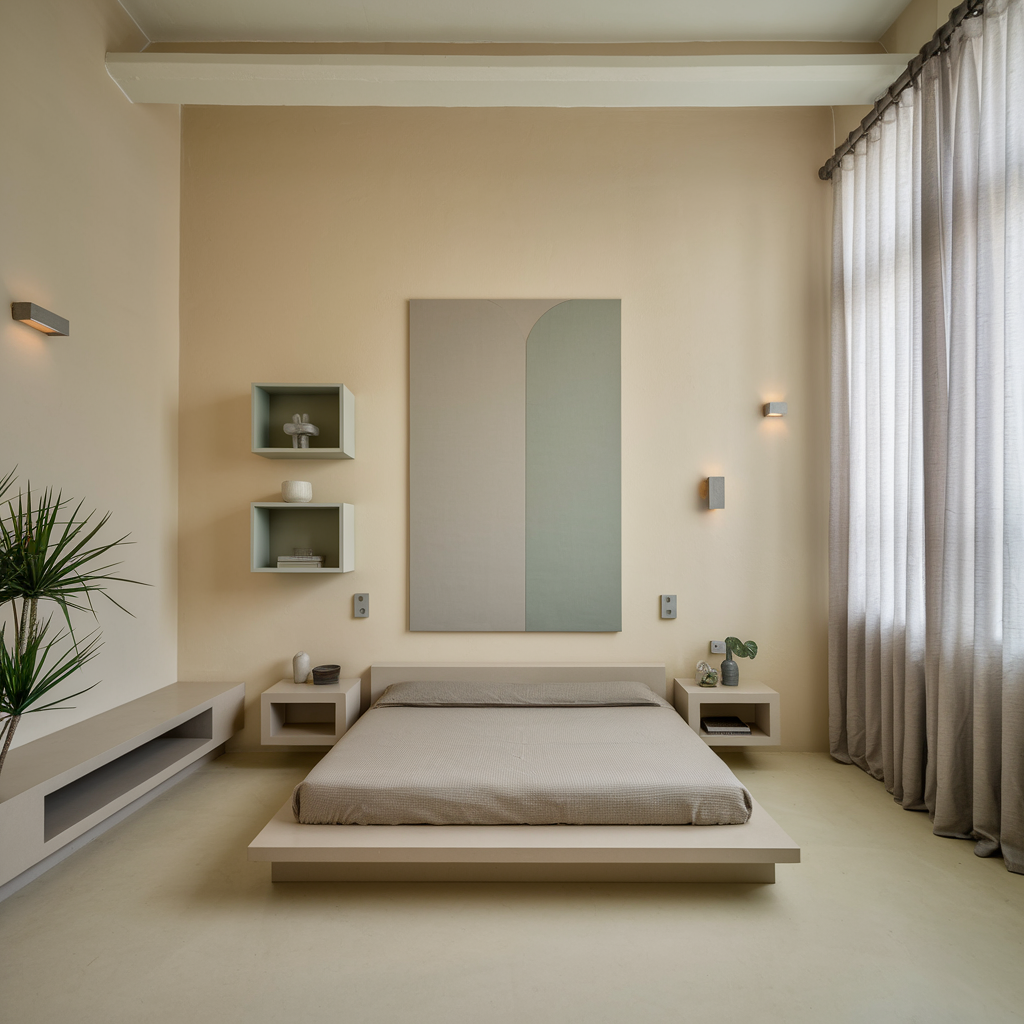
Maintaining open floor space is essential in a minimalist bedroom to create a sense of airiness and simplicity. Choosing furniture with a smaller footprint, like a platform bed or compact nightstand, leaves more room for movement.
Wall-mounted lighting or floating shelves can replace bulky floor lamps and bookcases, keeping the floor area uncluttered. Arranging furniture along the perimeter of the room rather than the center helps preserve a spacious layout.
Using multi-functional pieces, such as a bench with hidden storage, keeps essential items organized without overcrowding the floor, reinforcing the minimalist aesthetic while promoting practicality.
16. Incorporating Subdued Artwork
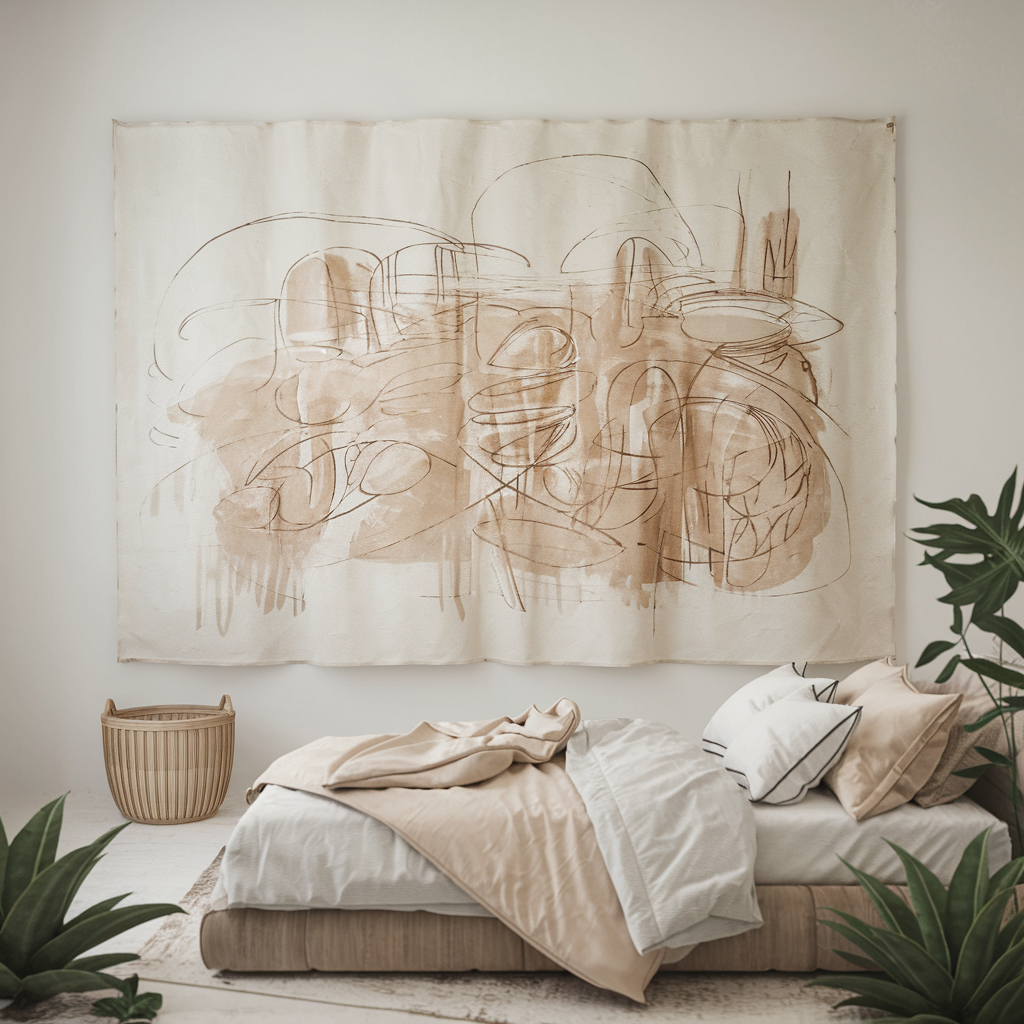
Subdued artwork adds character to a minimalist bedroom without disrupting its calm and balanced feel. Monochromatic prints, such as black-and-white photographs or abstract sketches, add visual appeal while maintaining a neutral palette.
Simple line art framed in natural wood or matte black enhances the room’s modern simplicity. A single oversized piece, like a softly colored landscape painting, can serve as a subtle focal point above the bed or dresser.
Grouping a few small, understated pieces in a symmetrical arrangement keeps the look cohesive and avoids visual clutter. Choosing artwork with muted tones and clean designs ensures the space remains serene and harmonious.
17. Softening the Space with Rugs
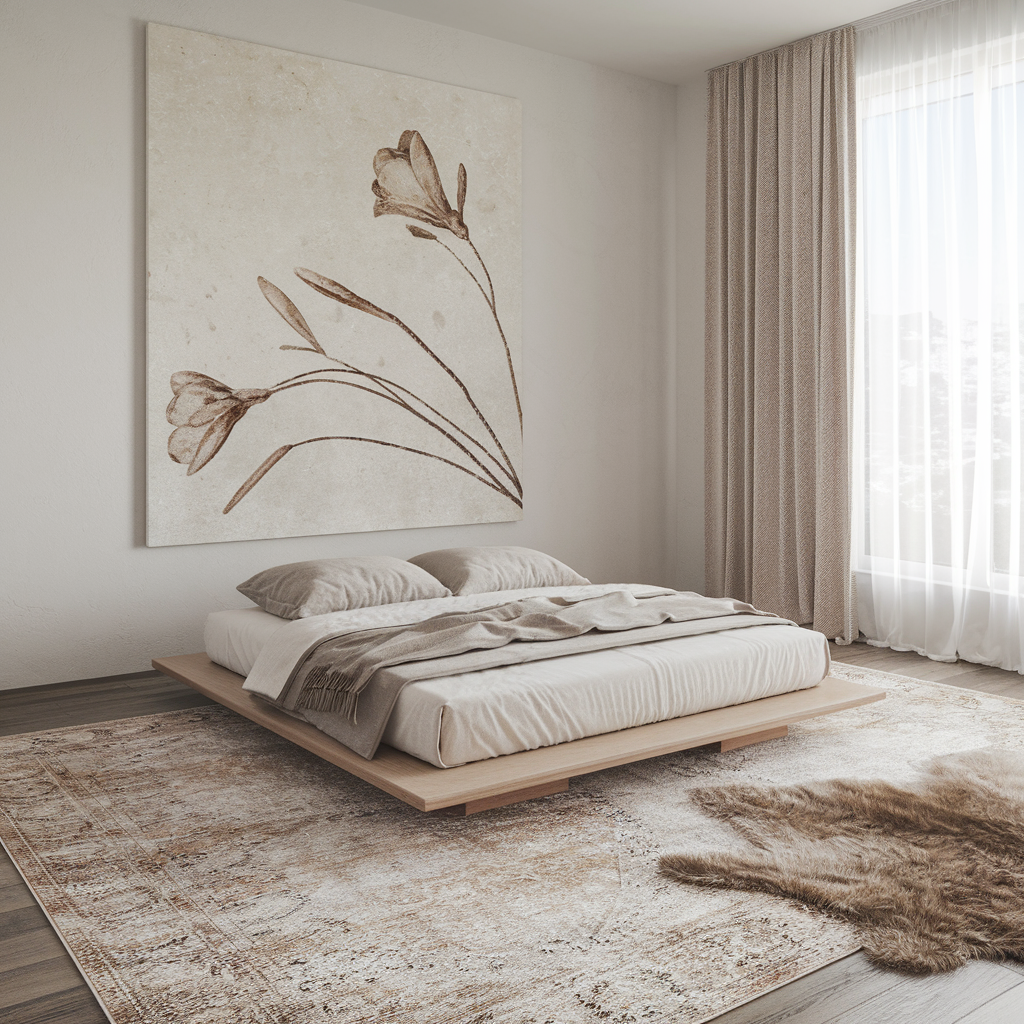
Softening the space with rugs brings warmth and comfort to a minimalist bedroom while maintaining its understated elegance. A large, neutral-toned area rug placed under the bed anchors the room and creates a cozy foundation.
Textures like plush wool or flat-woven cotton add tactile interest without detracting from the overall design. Layering smaller rugs, such as a sheepskin beside the bed, introduces a touch of softness where it’s most needed.
Choosing rugs in muted patterns or solid colors keeps the focus on the serene and uncluttered aesthetic, blending functionality with style.
18. Emphasizing Quality Over Quantity
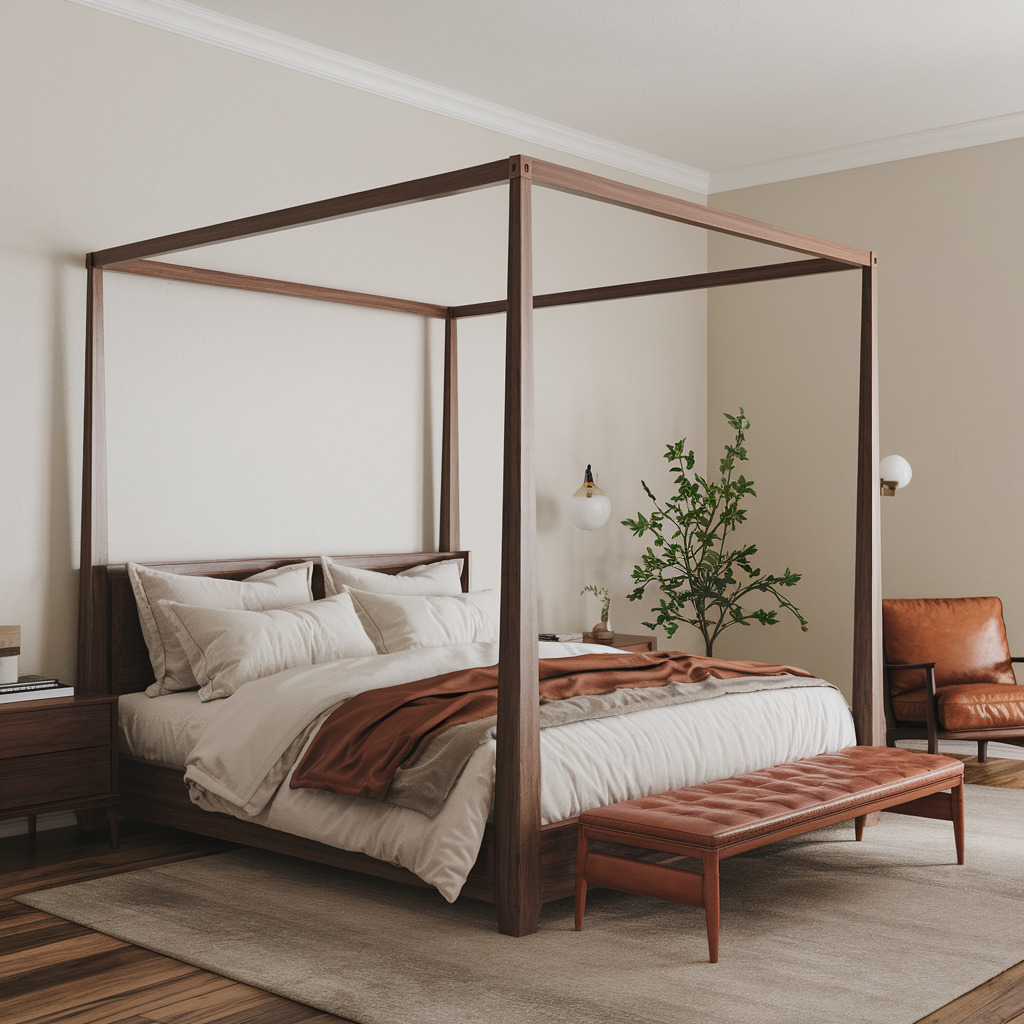
Emphasizing quality over quantity in a minimalist bedroom ensures an intentional and refined space. Selecting fewer, well-crafted pieces, such as a solid wood bed frame or high-thread-count bedding, enhances the room’s overall functionality and aesthetic.
High-quality materials like natural linen, wool, or leather bring durability and timeless appeal, making each item a worthwhile investment. Avoiding excessive decor or furniture creates a cleaner layout, allowing the craftsmanship of each piece to stand out.
This approach not only minimizes visual clutter but also fosters a sense of mindfulness by focusing on what truly adds value to the space.
19. Setting Boundaries for Personal Items
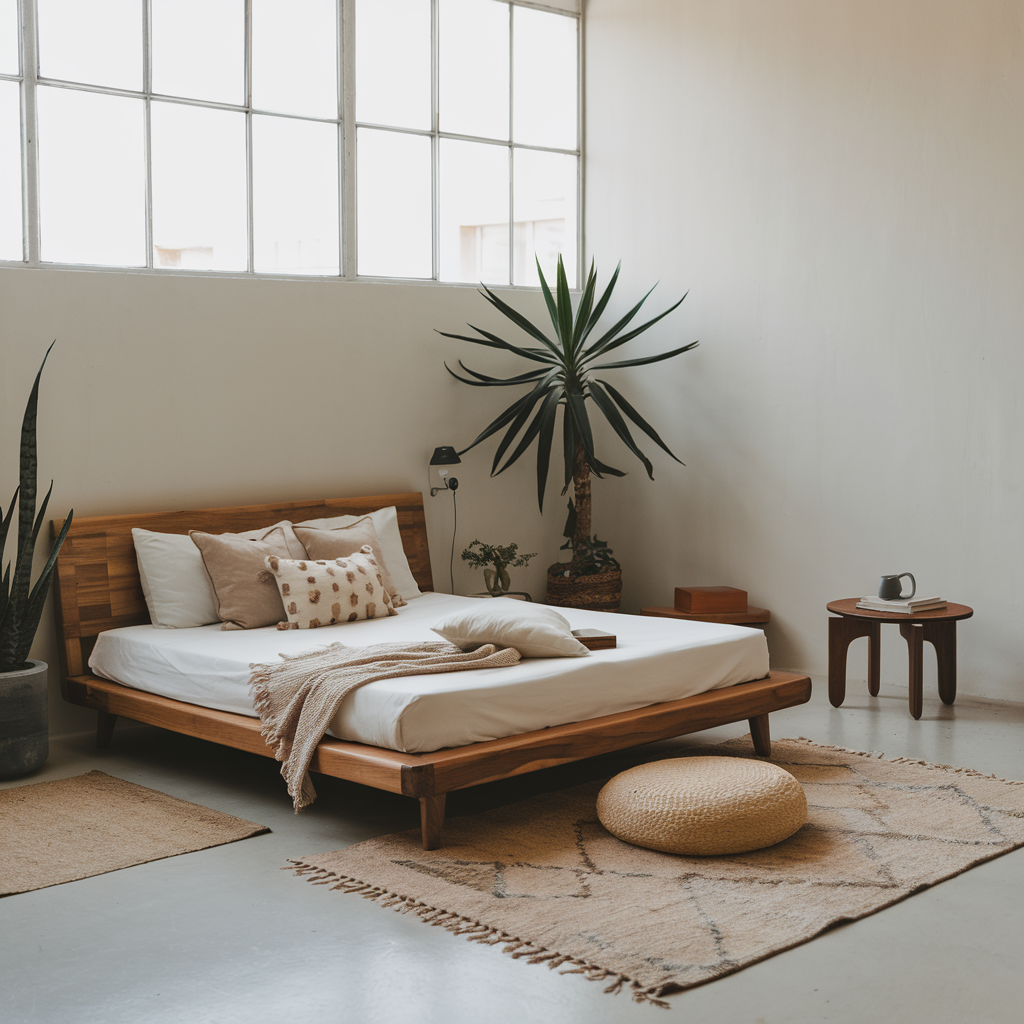
Setting boundaries for personal items in a minimalist bedroom helps maintain a tidy and serene environment. Designating specific storage spaces, such as drawers or bins, ensures that sentimental or everyday belongings are organized and not scattered around the room.
Limiting the number of visible items, like displaying only a few favorite books or a single framed photo, keeps the space uncluttered while still reflecting personal touches.
Rotating decorative pieces seasonally allows for variety without overcrowding the room with too many possessions at once. This mindful approach to curation ensures the bedroom remains a peaceful retreat while purposefully honoring meaningful items.
Conclusion
Creating a minimalist bedroom doesn’t mean sacrificing comfort or personality. By focusing on intentional design choices, subtle textures, and efficient use of space, you can craft a room that feels tranquil and welcoming.
Each idea on this list offers a way to enhance your space while keeping it free of unnecessary clutter. With these tips, your bedroom can become a peaceful haven that reflects your personal style while embracing the elegance of simplicity
Which of these minimalist bedroom ideas will you try first to create a clutter-free haven? Please share with us in the comments!

